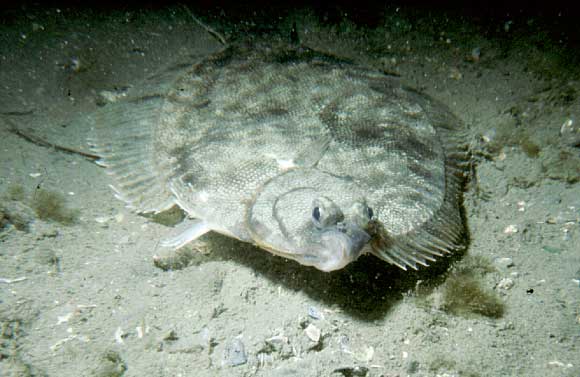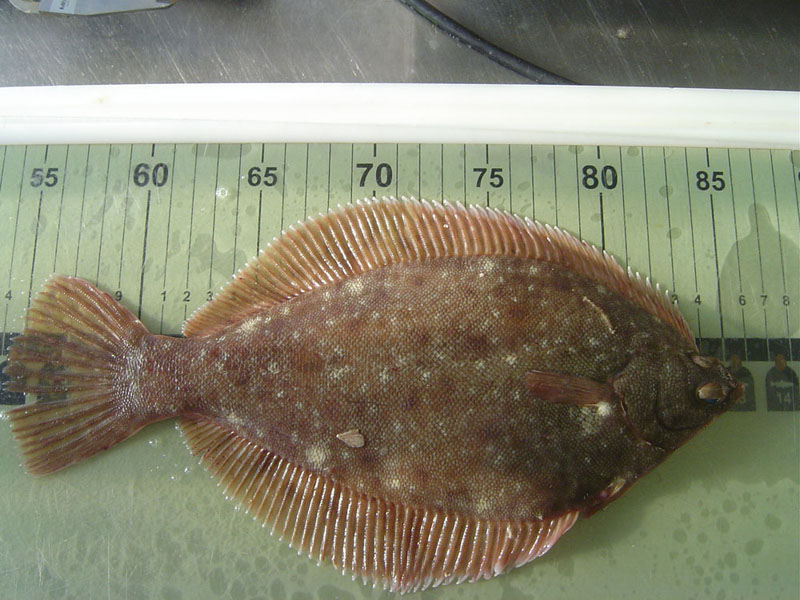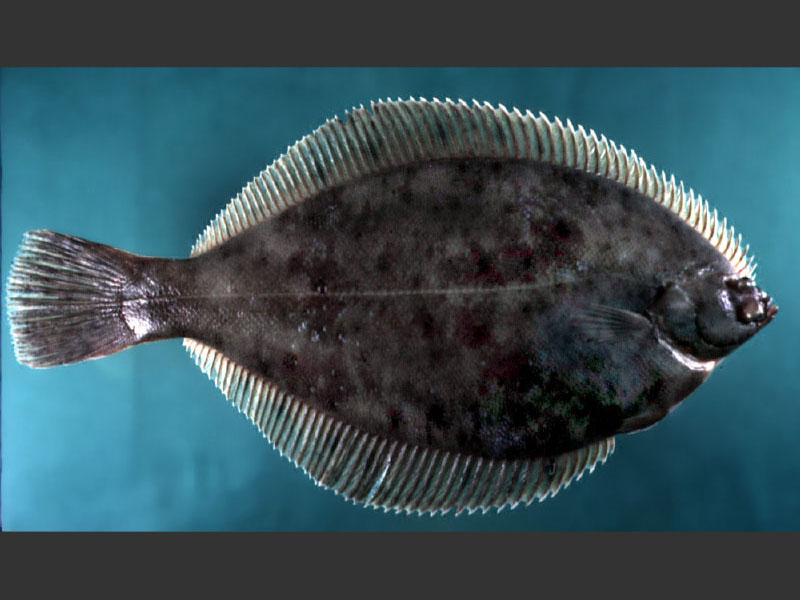
Pseudopleuronectes americanus
FAMILY
Pleuronectidae
TAXONOMY
Pleuronectes americanus Walbaum, 1792, New York.
Solea solea
Pleuronectes platessa
OTHER COMMON NAMES
English: Blackback, Georges Bank flounder, lemon sole, rough
flounder; French: Limande-plie rouge; Spanish: Solla roja.
PHYSICAL CHARACTERISTICS
Medium-sized, dextral flatfish with an oval and thick body with
a relatively wide caudal peduncle and a broadly rounded caudal
fin. The head is relatively small, with a small terminal mouth
with a small gape and thick, fleshy lips. Jaws on the blind side
are equipped with a series of incisor-like teeth, whereas the jaws
on the ocular side are toothless or nearly so. The lateral line is
nearly straight, with only a slight arch above the pectoral fin.
Ocular side scales are ctenoid, whereas blind side scales are
ctenoid in males and cycloid in juveniles and females. Winter
flounder vary in color, depending on the bottom where they
live. Larger specimens are dark muddy brown or reddish brown,
olive-green, or slate-colored to almost black. On the ocular side,
coloration varies from uniformly pigmented to patterned with
definite flecks, spots, and darker blotches of differing hues, depending
on the bottom type. The blind side usually is uniformly
white and translucent with a bluish tinge toward the body margins
and sometimes with yellow on the caudal peduncle. Winter
flounder can attain a length of 24.8–26.4 in (63–67 cm) and
weights to about 7.9 lb (3.6 kg). Winter flounder are relatively
long lived, reaching a maximum age of about 15 years. After
about age five, females begin to grow faster than males; they
also live longer than males.
DISTRIBUTION
Western North Atlantic in estuarine and marine waters along
the Atlantic coast of North America from Labrador south to
Georgia and also on the offshore banks. Most abundant between
the Gulf of Saint Lawrence and Chesapeake Bay.
HABITAT
Brackish waters of tidal rivers, estuaries, and river mouths to
areas on the inner continental shelf. Larger and older fish tend
to inhabit deeper waters than do younger, smaller fish. Typical
inshore habitats consist of muddy sand, especially where the
sand is broken by patches of eelgrass; clean sand; clay; and
pebbly and gravelly ground. Offshore, winter flounder usually
are found on hard bottom. They can survive a wide range of
temperatures, from nearly the freezing point of saltwater to
about 68–69.8°F (20–21°C). Their blood serum contains an
antifreeze protein that helps protect them against freezing.
BEHAVIOR
Diurnally active, with activity beginning at sunrise. At night
they lie flat, with heads resting on the bottom and eye turrets
retracted. On muddy bottoms, winter flounder usually lie
buried, all but the eyes, working themselves down into the
mud soon after settling on the bottom. Fish living on tidal flats
typically remain motionless during low tides but actively forage
during high tides. Can change color to match background surroundings,
ranging from whitish on white backgrounds to dark
brown or nearly black on dark sediments. Local conditions in
inshore waters appear to determine inshore
DISTRIBUTION
patterns,
whereas offshore movements seem to be associated with
extreme summer and winter conditions. In general, in summer
months adult winter flounder stay in the shallow shore zone
when the water temperature is not excessive and food availability
is adequate. If these conditions are not met, they may move
into deeper channels or offshore or may take evasive action.
During winter in the southern parts of their range, they remain
or move into shallow water to spawn, whereas in northern
regions they remain inshore in protected areas and move
offshore in exposed areas to avoid turbulence and drifting pack
ice. Winter flounder in deeper waters, such as Georges Bank,
remain there year-round. Winter flounder bury in sediments
when water temperatures are below 32°F (0°C) and ice crystals
are present in the water. They are active at water temperatures
up to 71.6°F (22°C), beyond which they become inactive. They
are sensitive to low levels (3 ppm) of dissolved oxygen.
FEEDING ECOLOGY AND DIET
Visual predators. Consume a wide variety of small invertebrates
and, rarely, small fishes, such as sand lance. Principal
food includes polychaetes, anthozoans, and amphipods but also
shrimps, small crabs and other crustaceans, ascidians,
holothurians, squids, bivalve and gastropod mollusks, and
sometimes fish eggs. They often bite off clam siphons that
protrude from the sand. While feeding, a winter flounder lies
with its head raised off the bottom with its anterior body
braced vertically against the bottom. Eye turrets are extended,
and the eyes move independently of each other. After sighting
its prey, the fish remains stationary, pointed toward the target,
and then lunges forward and downward to seize its prey. Winter
flounder are eaten by codfish, spiny dogfish, goosefish,
hakes, winter skate, smooth dogfish, striped bass, bluefish, sea
raven, seals, ospreys, gulls, blue herons, and cormorants.
REPRODUCTIVE BIOLOGY
In the fall, as gonads ripen, adult winter flounder remain in or
move into shallow water to spawn. They spawn in winter in
southern locations and in early spring (January to May) in
more northern locations. Spawning in inshore waters occurs
nearly at the seasonal lowest temperatures, which range from
31.1 to 35.6°F (_0.5–2.0°C), depending on latitude. Spawning
on Georges Bank happens at temperatures ranging from about
37.9 to 41.9°F (3.3–5.5°C). Winter flounder spawn on sandy
bottom and algal mats, often in shallow water. Spawning in estuaries
occurs in areas with salinity levels as low as 11.4 ppt.
Males mature at age two and females at age three off New
York, when fish are 7.9–9.8 in (20–25 cm) in total length. Fish
in more northern areas mature later—age three years and four
months for males and three years and six months for females
north of Cape Cod and age six for males and seven for females
in Newfoundland. Maturity seems to be a function of size
rather than age. On Georges Bank, the mean age at maturity is
just under two years for both sexes.
Females produce, on average, 500,000 eggs, but larger fish
can produce up to 3.5 million eggs. Winter flounder migrate
into shallow water or estuaries and coastal ponds to spawn, and
tagging studies show that most return repeatedly to the same
spawning grounds. They are batch spawners. Females in captivity
spawned up to 40 times and males up to 147 times.
Males initiated all observed spawning events, which occurred
throughout the night but primarily between sunset and midnight.
Spawning by one pair frequently elicited sudden convergence
and spawning by secondary males. Strict pair spawning is
uncommon. Male and female activity patterns were almost entirely
nocturnal during the reproductive season but became increasingly
diurnal during the post-spawning season. Eggs are
fertilized outside the body and sink to the bottom, where they
stick together in clusters. Incubation takes place over 15–18
days at 37–37.9°F (2.8–3.3°C). Young larvae hatch at about
0.12–0.14 in (3.0–3.5 mm). Metamorphosis is complete when
larvae are only 0.31–0.35 in (8–9 mm) long. Winter flounder
exhibit little movement from areas where they settle, unless
seasonal temperatures become extreme.
CONSERVATION STATUS
Not threatened, although their numbers have diminished substantially
since the 1970s, and the stocks throughout most, if
not all, of the species’ range are considered to be overexploited.
Overfishing, pollution, and habitats destruction all contribute
to reductions in stock sizes of this species. Current
fishery management plans are to restore stock sizes to former
levels. As of 2002 little success was evident in these attempts.
SIGNIFICANCE TO HUMANS
Highly desirable commercial and recreational species. Winter
flounder were the most frequently captured flatfish taken by
recreational fishers along the eastern coast of the United States
until about 1970. Since then, landings of fish in both commercial
and recreational fisheries have declined substantially.
Other popular Animals
Photo Gallery of - Winter flounder





 Animalia Life
Animalia Life